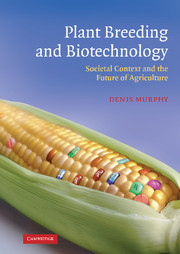Book contents
- Frontmatter
- Contents
- Preface
- Acknowledgements
- Using this book
- Nomenclature and terminology
- Abbreviations and glossary
- Introduction
- Part I The science of plant breeding
- 1 Origins of plant breeding
- 2 Creating new genetic variation
- 3 Modern high-tech breeding
- Part II The societal context of plant breeding
- Part III Turmoil and transition: the legacy of the 1980s
- Part IV The agbiotech paradigm
- Part V Increasing global crop production: the new challenges
- Part VI Plant breeding in the twenty-first century
- Notes
- References
- Index
2 - Creating new genetic variation
Published online by Cambridge University Press: 07 May 2010
- Frontmatter
- Contents
- Preface
- Acknowledgements
- Using this book
- Nomenclature and terminology
- Abbreviations and glossary
- Introduction
- Part I The science of plant breeding
- 1 Origins of plant breeding
- 2 Creating new genetic variation
- 3 Modern high-tech breeding
- Part II The societal context of plant breeding
- Part III Turmoil and transition: the legacy of the 1980s
- Part IV The agbiotech paradigm
- Part V Increasing global crop production: the new challenges
- Part VI Plant breeding in the twenty-first century
- Notes
- References
- Index
Summary
Weep not that the world changes – did it keep
A stable, changeless state, it were cause indeed to weep
William Cullen Bryant (1794–1878) MutationIntroduction
For the past three hundred years, crop breeders have had access to a considerable amount of existing variation resulting from spontaneous mutation, and also from the various genetic manipulations, such as hybridisation, that they learned to perform as they improved their understanding of plant reproduction. By collecting varieties and landraces from around the world, breeders were also able to exploit a great deal of the variation present in the gene pool of the crop species itself. Breeders had learned how to force crops to hybridise with some of their wild relatives, and even with other more distantly related species. Not even the genus barrier could withstand their assault as the first experimental manmade intergenic hybrids were produced in the mid nineteenth century. At this stage, many of these achievements were only successful in glasshouses or field plots and had not yet resulted in the production of any new varieties of the major staple crops. To a great extent, farmers at the beginning of the twentieth century were still reliant on traditional crop landraces. Organised systems for the dissemination of improved seed stocks from the new scientific breeding programmes were just beginning to be established in a few countries, but were still far from effective.
- Type
- Chapter
- Information
- Plant Breeding and BiotechnologySocietal Context and the Future of Agriculture, pp. 23 - 37Publisher: Cambridge University PressPrint publication year: 2007



